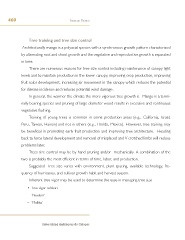Page 460 - FRUTAS DEL TRÓPICO
P. 460
460 Frutas del trópico
Tree training and tree size control
Architecturally mango is a polyaxial species with a synchronous growth pattern characterized
by alternating root and shoot growth and the vegetative and reproductive growth is separated
in time.
There are numerous reasons for tree size control including maintenance of canopy light
levels and to maintain production in the lower canopy, improving crop production, improving
fruit color development, increasing air movement in the canopy which reduces the potential
for disease incidence and reduces potential wind damage.
In general, the warmer the climate the more vigorous tree growth is. Mango is a termi-
nally bearing species and pruning of large diameter wood results in excessive and continuous
vegetative flushing.
Training of young trees is common in some production areas (e.g., California, Israel,
Peru, Taiwan, Hainan) and not in others (e.g., Florida, Mexico). However, tree training may
be beneficial in promoting early fruit production and improving tree architecture. Heading
back to force lateral development and removal of misplaced and V-crotched limbs will reduce
problems later.
Trees size control may be by hand pruning and/or mechanically. A combination of the
two is probably the most efficient in terms of time, labor, and production.
Suggested tree size varies with environment, plant spacing, available technology, fre-
quency of hurricanes, and cultivar growth habit and harvest season.
Inherent tree vigor may be used to determine the ease in managing tree size
• Low vigor cultivars
– ‘Neelum’
– ‘Mallika’
Universidad Autónoma de Chiapas

